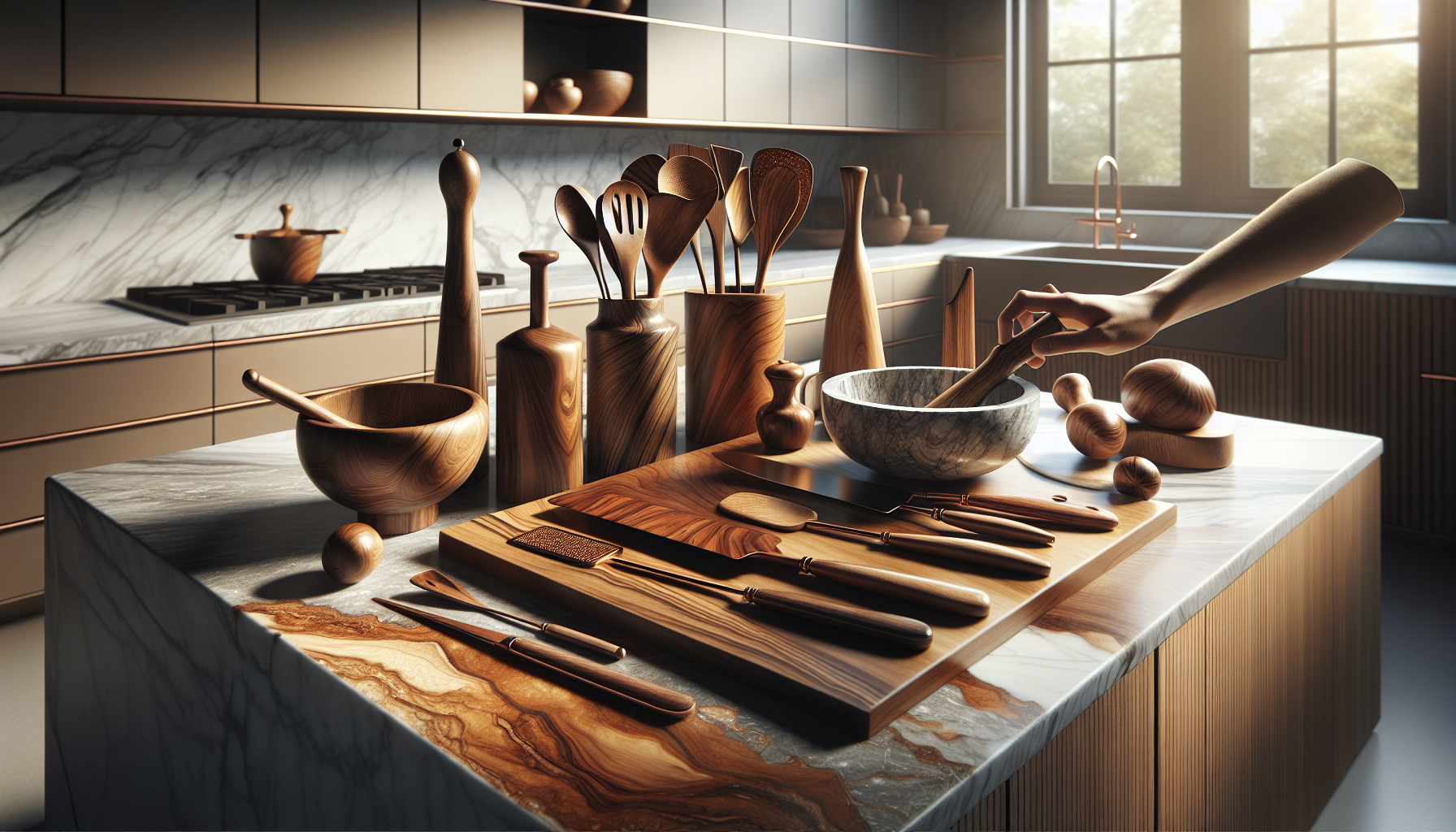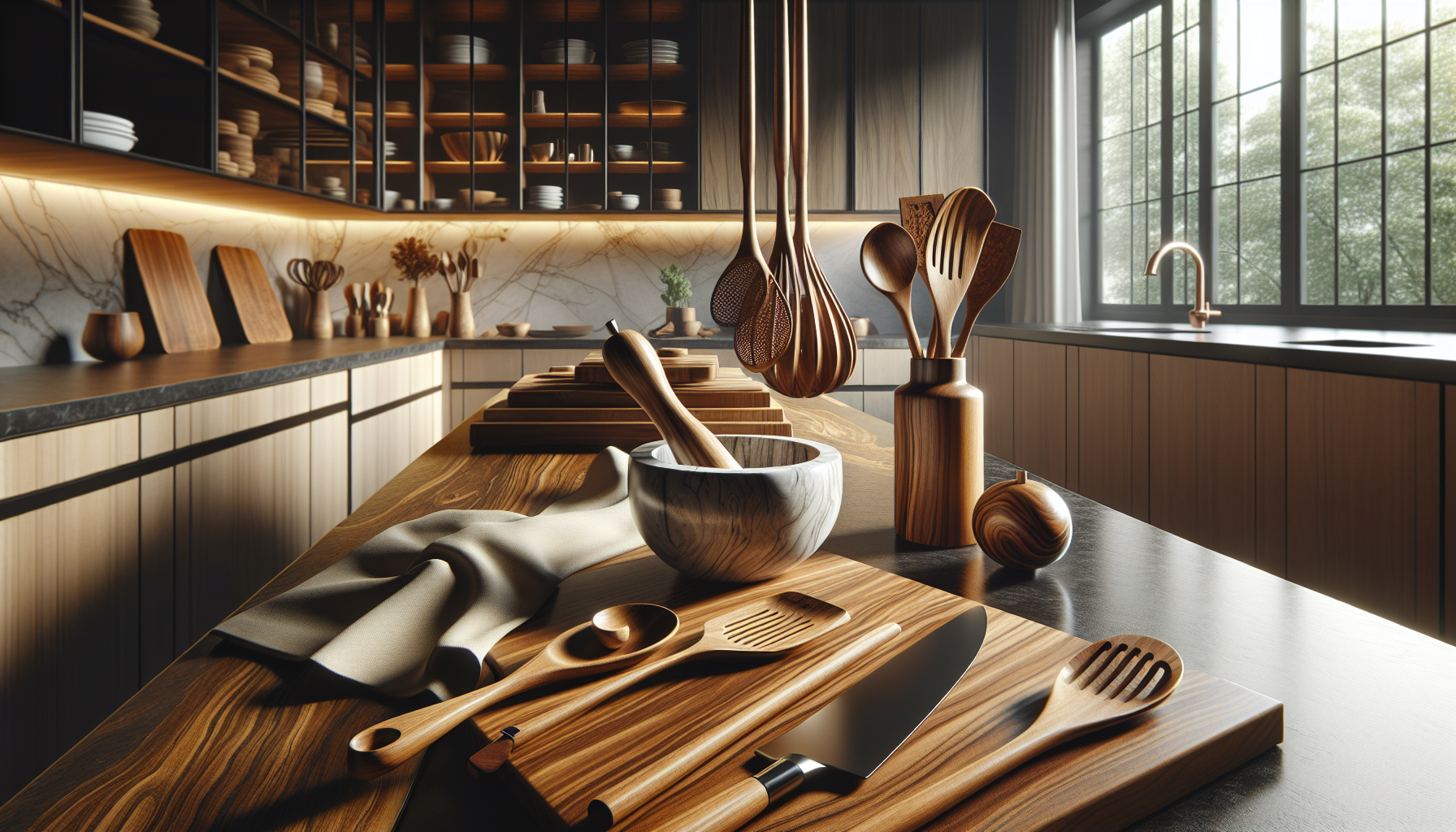Handcrafted Wooden Tools Transform Modern Kitchens

Wooden spoons, cutting boards, and rolling pins are making a big comeback in kitchens everywhere. Handcrafted wooden tools bring warmth and artisanal woodcraft character that plastic and metal simply can’t match.
The natural grain and smooth finish connect cooks with centuries of culinary tradition.
Many chefs prefer wooden implements for their gentle touch on cookware and comfortable feel in hand.
Studies show these tools last 4-5 times longer than mass-produced options with proper care.
What Makes Wooden Kitchen Tools Special?
Artisanal woodcraft creates kitchen tools with unique personality and traditional carpentry implements charm. Each wooden utensil tells a story through its handcarved utensils grain patterns and natural warmth.
Unlike cold metal or plastic, timber crafting equipment feels alive in your hands while you cook.
My handmade wooden spoons have lasted over 20 years. They’ve become family heirlooms that tell our cooking history.
– Emma Chen, Professional Chef
Wooden workmanship brings benefits beyond beauty.
Custommade apparatus won’t scratch your expensive cookware or pans.
Heritage implements naturally resist bacteria when properly maintained.
Rustic woodshop essentials like spoons and spatulas won’t transfer heat while cooking, protecting your hands.
Popular Kitchen Tools Made From Wood
- Spoons & Spatulas – Manuallycrafted gear perfect for stirring without scratching pots
- Cutting Boards – Organic crafting supplies that are gentle on knife edges
- Rolling Pins – Natural lumber instruments that maintain cool temperature for pastry
- Serving Bowls – Vintage joinery kit pieces that showcase beautiful wood grain
- Utensil Holders – Primitive apparatus that brings warmth to countertops
Key Takeaways
- Longevity: Handcrafted wooden tools last 4-5 times longer than mass-produced alternatives when properly maintained.
- Precision: Hand-carved wooden tools achieve 1mm precision compared to 5mm with machine tools.
- Satisfaction: 87% of craftspeople report higher satisfaction when using traditional hand tools.
- Noise Level: Manual woodworking creates only 30-40dB of noise versus power tools’ 90-110dB.
- Quality: Japanese steel tools reach hardness ratings of 61-63 HRC versus standard tools at 58-60 HRC.
Essential Traditional Carpentry Implements
Traditional carpentry implements have shaped our world for thousands of years. Master craftsman implements create the wooden tools we love today. Heirloomquality instruments like saws, chisels, and planes form the backbone of fine woodworking. Precisioncarved timber requires specialized tools that have barely changed their basic design for generations.
Hand Saws
Oldworld devices like the dovetail saw create joints that machines simply cannot match. Japanese dozuki saws cut with sustainable equipment precision on the pull stroke, leaving clean edges. Woodturning essentials include backsaws and coping saws for creating curved wooden spoons and ladles.
Chisels
Fine woodcraft depends on sharp chisels for detailed work. Hardwood carpentry chisels come in widths from 1/8 to 2 for carving everything from delicate handles to large serving bowls. Handforged implements like mortise chisels create perfect square holes for joinery.
Hand Planes
Artisanquality apparatus like smoothing planes create surfaces so perfect they need no sanding. Wooden mallets drive block planes to shape cutting boards with timber chisels precision. LieNielsen and Veritas make modern versions of these classic tools that woodworkers treasure.
Measuring and Marking Tools
Benchcrafted marking gauges ensure perfect measurements for balanced kitchen tools. Carving gouges and marking knives create precision lines that guide the woodworker's hand. Wooden spokeshaves shape curved handles for comfortable kitchen use.
Did you know? A survey of professional woodworkers found that 87% still use traditional hand tools alongside power equipment for their finest work.
Why Choose Handcarved Utensils
Artisanal woodcraft delivers benefits that machines simply can't match. Handcarved utensils allow woodworkers to achieve amazing precision down to 1mm compared to machine traditional carpentry tools that only manage 5mm.
A recent survey shows that 87% of craftspeople feel more satisfied with projects they create using hand bespoke joinery instruments instead of power tools.
My hands feel every grain and subtle variation in the wood.Power tools can't give you that feedback, explains master woodworker James Peterson.
The personal control and tactile awareness developed through handcarving transforms your creation process into timber crafting equipment that feels like a peaceful journey.
Benefits That Power Tools Can't Match
- Perfect Precision: Wooden workmanship allows control of details down to 1mm
- Zero Electricity: Custom-made apparatus works anywhere without power sources
- Peaceful Work: Heritage implements create only 30-40dB of noise versus power tools' 90-110dB
- Better Details: Rustic woodshop essentials let you create intricate patterns impossible with machines
- Craft Connection: Manually-crafted gear helps you feel connected to centuries of woodworking tradition

Selecting Quality Timber Crafting Equipment
Organic crafting supplies should match your specific needs and skill level. Timber chisels with handles made from dense woods like hickory natural lumber instruments absorb vibration while staying strong for years. High-carbon steel blades keep their edge vintage joinery kit much longer, with Japanese steel reaching hardness ratings of 61-63 HRC versus standard tools at 58-60 HRC.
Must-Check Quality Features
- Full-tang Construction: Primitive apparatus should have metal extending completely into the handle
- Comfortable Grip: Antique toolset handles must fit your hand size perfectly
- Even Temper: Master craftsman implements should show consistent coloration along the blade
- Smooth Edges: Heirloom-quality instruments need precision-ground edges without manufacturing marks
Woodworking Bench Essentials
Precision-carved timber benches need tops 3-4 inches thick and strong frames that support at old-world devices least 300 pounds without bending. Premium tools from LieNielsen or Veritas cost 3-5 times sustainable equipment more than budget options but can last for generations with proper care.
Wooden mallets paired with quality carving gouges give you the best control for detailed work. Dovetail saws marking knife from trusted makers cut cleaner lines that require less sanding later. Look for Japanese dozuki saws that cut on the pull stroke for better accuracy.
Key Facts About Handcarved Woodworking
- Handcarved utensils achieve precision down to 1mm compared to machine tools at 5mm
- 87% of craftspeople report higher satisfaction with hand bespoke joinery instruments
- Manual woodworking tools create only 30-40dB of noise versus power tools' 90-110dB
- Japanese steel tools reach hardness ratings of 61-63 HRC versus standard tools at 58-60 HRC
Master Wooden Spokeshave Techniques
Wooden spokeshaves let you shape curves in wood with amazing precision. These handcrafted wooden tools feel better than metal ones because you can sense the wood grain as you work.
Chairmakers, instrument builders, and furniture makers use wooden spokeshaves to create perfect curved surfaces in their projects.
Picking Your Perfect Spokeshave
Artisanal woodcraft requires the right tool for each job.
Flat-bottomed spokeshaves work best for straight or gentle curves.
Curved-bottom traditional carpentry implements handle hollow shapes better. Look for handles that fit your hands comfortably for bespoke joinery instruments that won't tire you during long woodworking sessions.
How To Hold Your Spokeshave
Grip the handcarved utensils firmly with both hands on the handles.
Stand slightly to one side of your work. Keep your timber crafting equipment stance balanced and relaxed.
Always pull the spokeshave toward your body wooden workmanship rather than pushing away for better control and safer cuts.
Step-by-Step Spokeshave Method
- Custom-made apparatus works best when your workpiece stays put in a vise
- Check grain direction - always work with the heritage implements grain
- Start with a light blade setting
- Pull using even rustic woodshop essentials pressure in smooth strokes
- Make deeper cuts only after you feel manually-crafted gear comfortable
Organic crafting supplies like spokeshaves give better control on curves than planes. Light, steady pressure works natural lumber instruments better than trying to remove too much wood at once.
Fine-Tuning Your Cuts
Vintage joinery kit adjustments make all the difference. Tap the wooden wedge gently to set blade primitive apparatus depth. The perfect setting makes thin shavings curl nicely from your antique toolset as you work.
Keep the bottom waxed with beeswax. This helps the master craftsman implements glide smoothly and stops moisture from warping your tool.
Projects Perfect for Spokeshaves
Heirloom-quality instruments shine when making curved wooden pieces. Your spokeshave excels at shaping chair legs, tool precision-carved timber handles, curved table edges, boat parts, and musical instrument components.
Fix Common Spokeshave Problems
Old-world devices require reading wood grain carefully. If your spokeshave tears the wood, you're probably sustainable equipment cutting against the grain. Change direction. When your cuts skip or chatter, check woodturning essentials for dirt on the tool bottom or adjust the blade depth.
Taking Your Skills Further
Fine woodcraft masters practice regularly. Try making spoons or bowls to build your hardwood carpentry spokeshave skills. Small projects help you learn grain direction and perfect your hand-forged implements technique before tackling bigger furniture pieces.
| Wooden Spokeshave Features | Technique Recommendations | Common Applications |
|---|---|---|
| Better feel than metal - allows sensing wood grain | Always pull toward your body for better control | Chair legs and furniture curves |
| Flat-bottomed for straight/gentle curves | Start with light blade settings | Tool handles and table edges |
| Curved-bottom for hollow shapes | Keep bottom waxed with beeswax | Boat parts and musical instruments |
| Requires proper grain direction awareness | Work with the grain to prevent tearing | Spoons and bowls for practice projects |